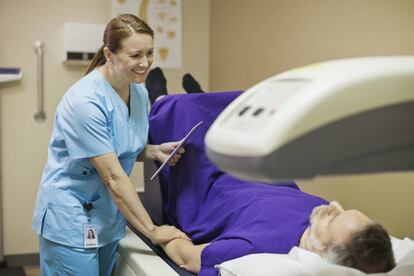The rise of osteoporosis in men
This “silent disease” is found twice as often in women, but as male lifespans increase so does the rate of this brittle-bone condition

Osteoporosis, a disease causing the skeleton to weaken and bones to break, is a significant threat to more than two million men in the United States today. It is estimated that one-fifth to one-third of all hip fractures occur in men and that vertebral (spine) fractures occur about half as often in men as in women, making this brittle-bone condition not just a “woman’s disease.” In addition, when osteoporosis is found in men, it can lead to a significant threat to their mobility and independence.
Often referred to as the “silent disease,” osteoporosis can progress with few if any symptoms until a bone is broken. Men are less likely to develop the disease for several reasons: they have a larger skeleton, bone loss begins at a later age and progresses more slowly in men than in women, and men face no period of rapid hormonal change as women do during the transition to menopause. But, as the lifespan of men continues to rise, the incidence of osteoporosis in men is rising right along with it. Millions of men have low bone-mineral density, putting them at risk of developing osteoporosis. If a man has a hip fracture, they are more likely to die as a result.
Osteoporosis, the “silent disease,” can progress with few if any symptoms until a bone is broken
Causes of osteoporosis in men
There are two main types of osteoporosis: primary and secondary. Primary osteoporosis is caused either by bone loss, or the cause is unknown.
The majority of men with osteoporosis will have at least one secondary cause. Secondary causes of osteoporosis are caused by certain lifestyle behaviors, diseases, or medications. Here are some causes of secondary osteoporosis in men:
- Glucocorticoid medications
- Other immunosuppressive drugs
- Hypogonadism (low testosterone levels)
- Smoking
- Excessive alcohol consumption
- Chronic obstructive pulmonary disease and asthma
- Cystic fibrosis
- Gastrointestinal disease
- Immobilization
- Hyperparathyroidism
- Inadequate physical exercise
How osteoporosis is diagnosed in men
A medical workup to diagnose osteoporosis will include a complete medical history, x-rays, and urine and blood tests. A bone-mineral density test should also be ordered. This test can identify osteoporosis, determine your risk for fractures and measure response to osteoporosis treatment. The most widely recognized bone-mineral density test is called a central dual-energy x-ray absorptiometry or central DXA test. It is painless and is simply a matter of lying on a table as the machine measures bone density.
If osteoporosis is detected before significant bone loss has occurred it can be effectively treated
Prevention and treatment of osteoporosis for men
If osteoporosis is detected before significant bone loss has occurred it can be effectively treated.
But currently there are no official recommendations for osteoporosis screening in men. This leaves screening decisions in the hands of men’s physicians or the man himself in asking about whether he should be screened for osteoporosis or not. The Endocrine Society that represents physicians and scientists specializing in hormonal issues does have guidelines for men when it comes to osteoporosis:
- All men 70 and older should have a bone-density test of the hip and spine. Any man between the ages of 50 to 69 who have additional risk factors such as low body weight, hypogonadism, long-term use of corticosteroids or a history of alcohol abuse, should be screened.
- Men found to be at high risk for fractures based on their bone density and clinical risk factors should be treated with medication and monitored with repeat testing every one to two years.
- At-risk men should consume 1,000 to 1,200 milligrams of calcium a day – from food first then supplements if needed.
- All men should do 30 to 40 minutes of weight-bearing exercise three or four times a week.
- Alcohol intake should be kept at moderate consumption of no more than two drinks a day and men who smoke should quit.
- Men with low blood levels of vitamin D should take a vitamin D3 supplement. Doses of 1,000 to 2,000 IU a day are usually enough to get blood levels to 30 ng/ml or above, which is considered optimal. Some men, however, may need larger doses.
Dr. Samadi is a board-certified urologic oncologist trained in open and traditional and laparoscopic surgery and is an expert in robotic prostate surgery. He is chairman of urology, chief of robotic surgery at Lenox Hill Hospital. He is a medical contributor for the Fox News Channel's Medical A-Team. Follow Dr. Samadi on Twitter, Instagram, Pinterest, SamadiMD.com, davidsamadiwiki, davidsamadibio and Facebook
Tu suscripción se está usando en otro dispositivo
¿Quieres añadir otro usuario a tu suscripción?
Si continúas leyendo en este dispositivo, no se podrá leer en el otro.
FlechaTu suscripción se está usando en otro dispositivo y solo puedes acceder a EL PAÍS desde un dispositivo a la vez.
Si quieres compartir tu cuenta, cambia tu suscripción a la modalidad Premium, así podrás añadir otro usuario. Cada uno accederá con su propia cuenta de email, lo que os permitirá personalizar vuestra experiencia en EL PAÍS.
¿Tienes una suscripción de empresa? Accede aquí para contratar más cuentas.
En el caso de no saber quién está usando tu cuenta, te recomendamos cambiar tu contraseña aquí.
Si decides continuar compartiendo tu cuenta, este mensaje se mostrará en tu dispositivo y en el de la otra persona que está usando tu cuenta de forma indefinida, afectando a tu experiencia de lectura. Puedes consultar aquí los términos y condiciones de la suscripción digital.






























































